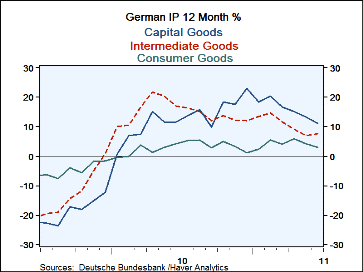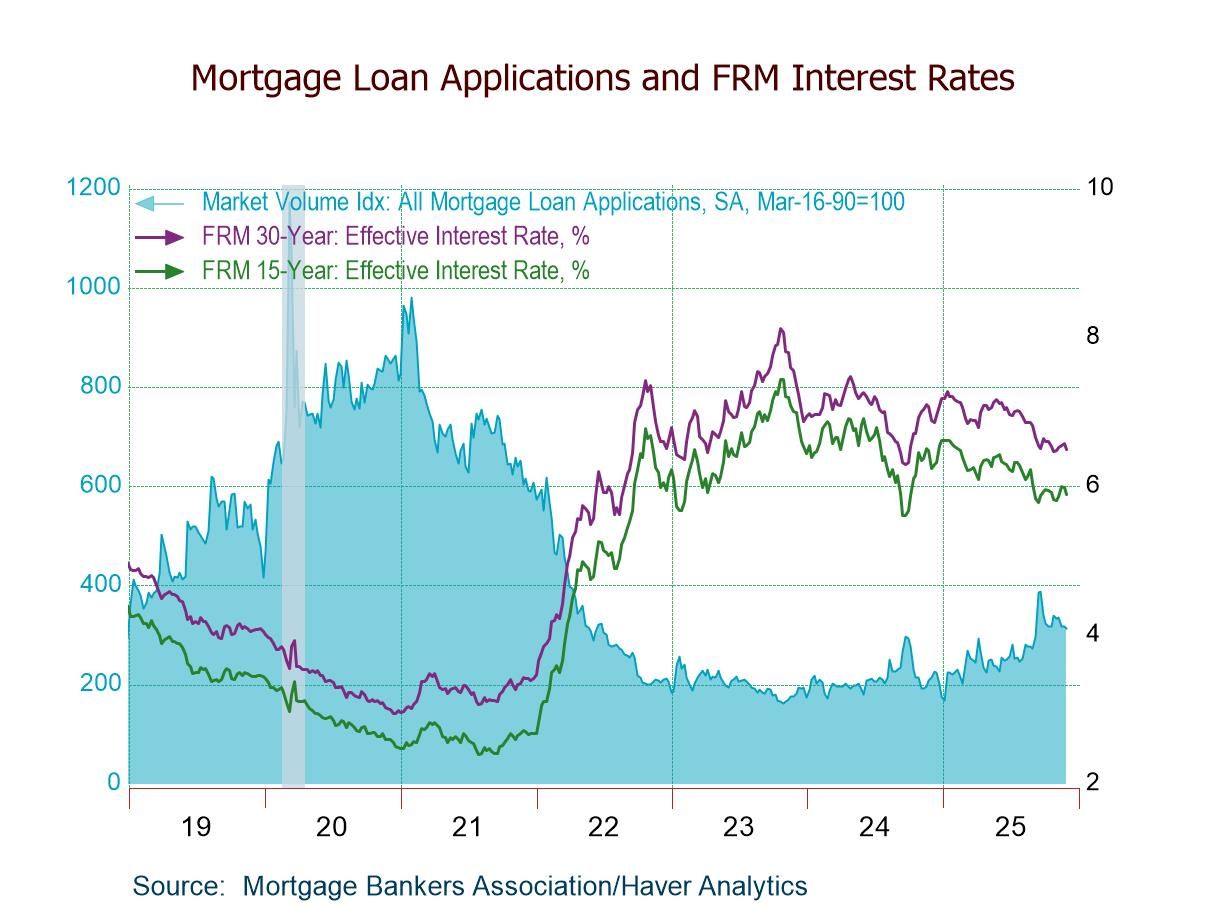 Global| Aug 05 2011
Global| Aug 05 2011German IP Slows Across Sectors; Is It A Harbinger Of More Slowing?
Summary
German IP fell in June. While orders were up with a lot of the strength in foreign orders, output lagged in June. Over three-months German IP is falling based on dropping consumer goods output and weak capital goods output. Still over [...]
 German IP fell in June. While orders were up with a lot of the strength in foreign orders, output lagged in June.
Over three-months German IP is falling based on dropping consumer goods output and weak capital goods output. Still
over six-months and 12-months output in Germany is still robust with growth rates of 6% and higher.
German IP fell in June. While orders were up with a lot of the strength in foreign orders, output lagged in June.
Over three-months German IP is falling based on dropping consumer goods output and weak capital goods output. Still
over six-months and 12-months output in Germany is still robust with growth rates of 6% and higher.
Still the sequential growth rates show that consumer goods output is lower and capital goods output is slowing. Intermediate goods output is without clear trend but it still posting solid-to-strong rates of growth.
With the recently completed second quarter in hand IP is still doing well at a rate of growth of 4.3%. Even consumer goods output is up at a 5.2% pace. Capital goods output has surged at a 9.4% annual rate. The numbers fell well for Q2 but they are configured to put the start of Q3 in a hole.
In the second quarter MFG IP has grown at an 8% annual rate as output fell by 1% in June.
Industrial output has some degree of volatility in it as matter of course. But this year there has been some pronounced slowing in the MFG PMIs and in indicators that point the way ahead. German orders have also fluctuated. Industrial output trends are still declining in Germany. The way ahead is not clear. Debt problems have spread and there is Europe perched on the precipice of a crisis, one that it might have avoided by being more decisive one year ago or even six months ago.
But part of the EMU problem, is that fiscal policies are not linked and Germany has been dragged kicking and screaming to each and every bailout meeting. The Teutonic tonic is to make sinners pay for their sins; it is not forbearance. Germans are very worried about moral hazard. The situation has now become direr because of these attitudes. It is not clear if the German policymakers ‘get it’ yet or if they are simply unwilling to lead and to explain to their electorate, one that opposes further bailouts, what costs are at stake. The stakes have risen to a point that the EMU is on the verge of being overwhelmed by selling pressures of a magnitude it may not be able to deal with on its own.
If so the epitaph will be EMU: too little, too late, for a zone that was formed too-soon.
EMU was not Every Man’s Union. Its desire seemed to be to have its cake and eat it too by binding foreign exchange rates and keeping governments separate. That was a critical and fatal compromise to get the monetary union in place. It’s a bit like the architecture of the Titanic that did not bother to take the walls of the water-tight compartments all the way up and seal them to the floor above. No one foresaw a gash in the ship that would cut across so many compartments that water would overflow a series of compartments and fill each one sequentially and sink the ship. Japan’s reactors had a design flaw that was their undoing as well. For Europe, it is a design flaw interacting with crisis to produce catastrophe. Yes, EMU has a design flaw, but unlike these other instances it can be fixed even in mid-crisis- but will it?
In retrospect Europeans were not as willing to be European as they thought. Europeans are still nationalists first and European second. And you see that - the consequences of that - when crisis breaks out. That is the feature of the zone that needs to be settled before this economic union can work. Lacking this core value of unity left the Union vulnerable. So not it now must decide whether it is to unravel or to try to cement the pieces together with stronger glue. This is decision time for Europe.
| Total German IP | |||||||
|---|---|---|---|---|---|---|---|
| SAAR Except M/M | Jun-11 | May-11 | Apr-11 | 3Mo | 6Mo | 12Mo | Q-2-Date |
| IP total | -1.1% | 0.9% | -0.4% | -2.5% | 7.6% | 6.6% | 4.3% |
| Consumer | -1.0% | 0.0% | 0.6% | -1.9% | 4.8% | 3.0% | 5.2% |
| Capital | -2.0% | 2.6% | -0.5% | 0.3% | 1.8% | 11.0% | 9.4% |
| Intermed | 0.3% | 0.8% | 0.6% | 6.8% | 16.8% | 7.6% | 8.1% |
| Memo | |||||||
| Construction | -4.5% | -0.2% | -3.2% | -27.5% | 76.1% | 3.1% | -4.6% |
| MFG IP | -1.0% | 1.5% | 0.0% | 2.1% | 8.0% | 8.1% | 8.0% |
| Real MFG Orders | 1.8% | 1.5% | 0.0 | 27.4% | 16.6% | 9.4% | 13.6% |
Robert Brusca
AuthorMore in Author Profile »Robert A. Brusca is Chief Economist of Fact and Opinion Economics, a consulting firm he founded in Manhattan. He has been an economist on Wall Street for over 25 years. He has visited central banking and large institutional clients in over 30 countries in his career as an economist. Mr. Brusca was a Divisional Research Chief at the Federal Reserve Bank of NY (Chief of the International Financial markets Division), a Fed Watcher at Irving Trust and Chief Economist at Nikko Securities International. He is widely quoted and appears in various media. Mr. Brusca holds an MA and Ph.D. in economics from Michigan State University and a BA in Economics from the University of Michigan. His research pursues his strong interests in non aligned policy economics as well as international economics. FAO Economics’ research targets investors to assist them in making better investment decisions in stocks, bonds and in a variety of international assets. The company does not manage money and has no conflicts in giving economic advice.






